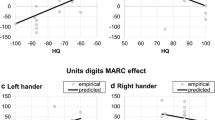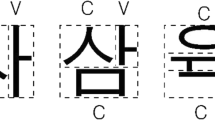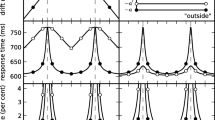Abstract
Eight experiments are reported that first establish and then explicate a serendipitous finding that judgments about whether digits are odd or even take longer for odd than for even digits. The slowing of judgments about odd digits is more pronounced when digit pairs or triples are used, but is still weakly present when a single digit must be classified. A similar effect is seen whenjudgments of nouns are based on whether the nouns are the names of living or dead objects. Nouns that name dead objects are judged more slowly than ones that name living objects. The concept “alive” is linguistically marked. Past research has shown that unmarked concepts are processed more rapidly than marked ones. The similarityinthepattera of results when.digits and words are judged is used to argue that the slower judgments about odd digits are due to the fact that “odd” is a linguistically marked and “even” a linguistically unmarked concept.
Article PDF
Similar content being viewed by others
References
Bradshaw, J. L., &Perriment, A. D. (1970). Laterality effects and choice reaction time in a unimanual two-finger task.Perception & Psychophysics,7, 185–188.
Cerella, J. (1985). Information processing rates in the elderly.Psychological Bulletin,98, 67–83.
Clapp, F. (1924).The number combinations: Their relative difficulty and the frequencyof their appearance in text-books (Bureau of Educat. ional Research Bulletin No. 1). Madison: University of Wisconsin.
Clark, E. (1973). What's in a word?On the child's acquisition ofsemantics in his first language. In T. Moore (Ed.),Cognitive development and the acquisition oflanguage (pp. 65–110). New York: Academic Press.
Clark, H. (1973). Space, time, semantics and the child. In T. Moore (Ed.),Cognitive development and the acquisition of language (pp. 27–63). New York: Academic Press.
Greenberg, J. (1966). Language universals. In T. Sebock (Ed.),Current trends in linguistics (Vol. 3, pp. 61–112). The Hague: Mouton.
Hines, T., & Clauss, E. (1982, August).The odd-odd effect. Poster presented at the 90th Annual Meeting ofthe American Psychological Association, Washington, DC.
Hines, T., Poon, L., Cerella, J., &Fozard, J. (1982). Age-related differences in the time course of encoding.Experimental Aging Research,8, 175–178.
Knight, F., &Behrens, M. (1928).The learning of the 100 addition and 100 subtraction combinations. New York: Longmans, Green.
Krueger, L. E. (1986). Why 2×2=5 looks so wrong: On the oddeven rule in product verification.Memory & Cognition,14, 141–149.
Krueger, L. E., &Hallford, E. W. (1984). Why 2+2=5 looks so wrong: On the odd-even rule in sum verification.Memory & Cognition,12, 171–180.
Posner, M, &Boies, S. (1971). Components of attention.Psychological Review,78, 391–408.
Shepard, R., Kilpatric, D., &Cunningham, J. (1975). The internal representation of numbers.Cognitive Psychology,7, 82–138.
Sherman, M. (1976). Adjectival negation and the comprehension of multiply negated sentences.Journal of Verbal Learning & Verbal Behavior,15, 143–157.
Sudevan, P., &Taylor, D. (1987). The cuing and priming ofcognitive operations.Journal of Experimental Psychology: Human Perception & Performance,13, 89–103.
Thorndike, E., &Lorge, I. (1944).The teacher's word book of 30,000 words. New York: Columbia University Teachers College.
Umilta, C., Frost, N., &Hyman, R. (1972). Interhemispheric effects on choice reaction times to one-, two-, and three-letter displays.Journal of Experimental Psychology,93, 198–204.
Zimmer, K., (1964). Affixed negation in English and other languages: An investigation of restricted productivity.Word,20(5, No. 2).
Author information
Authors and Affiliations
Additional information
Portions of the research reported here were supported by a Pace University Scholarly Research Fund grant (Hines & Clauss, 1982).
—Accepted by previous editor, Alice F. Healy
Rights and permissions
About this article
Cite this article
Hines, T.M. An odd effect: Lengthened reaction times for judgments about odd digits. Mem Cogn 18, 40–46 (1990). https://doi.org/10.3758/BF03202644
Received:
Accepted:
Issue Date:
DOI: https://doi.org/10.3758/BF03202644




